2022 Nest Cam News
Archive of the 2022 nesting season for Daisy & Duke at the BL Osprey Cam. They successfully fledged two young (Harbor & Harper) this year who were not banded. Scroll to the bottom to start from the beginning of the season.
September 6
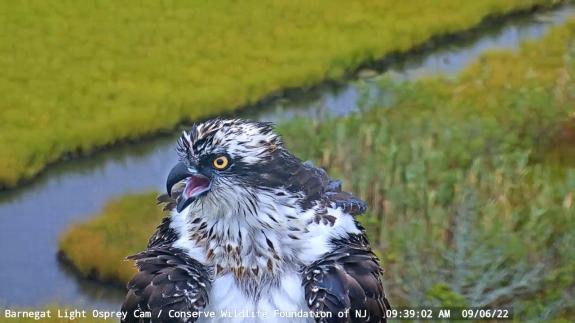 Harbor, the juvenile female calls for Duke to deliver prey at the nest.
Harbor, the juvenile female calls for Duke to deliver prey at the nest.
Autumn is upon us and migration is underway. Since the beginning of September, close to 600 ospreys have been counted at the NJ Audubon Cape May Hawkwatch. Daisy has left on her southbound migration (last seen on 8/28) and Harper has dispersed and may have started his migration (though juveniles don't always go south first). He was last seen on 8/30. Harbor continues to hang on the nest to rest, feed and preen and be supported by Duke. Harper is likely out perfecting his foraging skills. It has been delightful to see him with a variety of small prey that he caught himself, like a striped killifish, blue claw crab, blowfish, small menhaden, and a needlefish!
Soon Harbor and Duke will also begin their migration south to their wintering grounds. So far the tropics have been very quiet, which is great for migratory birds, including ospreys. Large tropical storms are known to suck up birds and can draw them out into the ocean and open water, where birds like ospreys do not fair well. We hope the tropics remain quiet, as osprey migration at Cape May peaks during the first week of October.
August 11
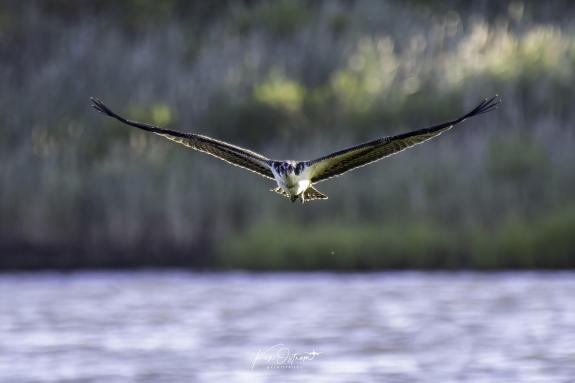 Harper soars above Barnegat Bay. Ken Ostrom
Harper soars above Barnegat Bay. Ken Ostrom
Both Harper and Harbor have fledged! As they become more confident with their flight skills, they will venture further from their home nest. Even though they are still dependent on the adults for food, they know that they need to start foraging on their own. As they take to the skies and fly with other ospreys, they will soon learn to find and catch prey on their own.
With a cold front passing through the area on Friday, it will set the stage for the early migrants to begin their southbound migration. Adult females will be the first to depart and arrive on their wintering grounds. The young will remain and the adult male will continue to provide food for them, but it will be less frequent which also encourages them to begin foraging for themselves.
July 29
Time does fly (and so do ospreys!)!! I can't believe that it has been a month since my last update... In that time the young have been named, Harbor for #1 (by my daughter) and Harper for the male (by my son) and developed into fledglings! On a personal note, I relocated during this time, so my life has been a bit hectic..
Moving on, today the oldest of the young, Harbor fledged! This morning at exactly 7:16am she took off from her nest. She was observed by viewers of the live stream flying over the marsh, bay and eventually taking her first bath. Her flight was notably strong and uneventful. Fledglings here are known to utilize the nearby shoreline to rest, which is a great natural feature for them. With the upgraded perches on the nest, we hope that they will allow for easy landing and takeoff for both fledglings as they become more experience on the wing.
Soon Daisy, the adult female will begin her southbound migration. Now that her young are older and not in need for close parental care, she can leave the nest to forage more for herself. Over the past several weeks we have seen her bring in dogfish and very large summer flounders. She is building up fat reserves that will help ensure her safe passage to her wintering grounds. BW
June 27
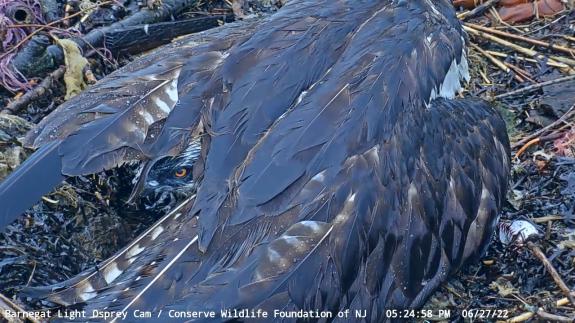 A 27 day old nestling peaks out from under Daisy's wing during a rainstorm.
A 27 day old nestling peaks out from under Daisy's wing during a rainstorm.
The two nestlings are almnost four weeks old where they reach the 75% developed benchmark. Their eyes are bright orange and their body feathers have emerged from pin. Their flight feathers are also growing quickly and have emerged from pin as well. At this age they are able to thermoregulate, but on hot days the female will still try to give them shade to keep them cool, and on cool rainy days she will do her best to keep them dry.
Rain hasn't been too plentiful, so the thunderstorms that passed through this afternoon gave them a chance to drink some as a flowed over their bills. Ospreys get the majority of water that they need from their prey, so a little freshwater is welcome on a warm summer day.
In other news, it has been interesting to see some plastic marine debris that was brought into the nest, including some balloons w/ ribbon and part of a softball. Daisy loved the ball so much that she was seen brooding it in the nest bowl.
At this point we are not planning to band the young for future tracking. We do not have any red aux. bands to deploy and our bucket truck cannot visit the site until July 12. Young will be 6 weeks old at that point and more difficult to band. Instead we will save resources and use our time to survey more nests for our 2022 NJ Osprey Census.
June 15
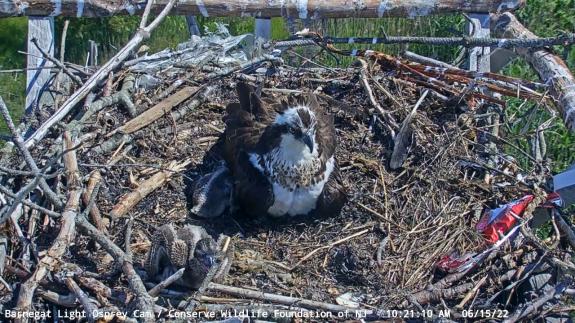
The two nestlings (who have yet to be named - viewers have asked my kids to name them..) -- referred to as one and two are now around 14 days old and have been thriving! At this age, they are at the point of being too big to brood and are able to keep warm, but it is not needed as much as summer is around the corner. The young, when not sleeping or eating, are starting to explore their nest and have better eyesight, so birds flying over the nest or people walking by are being noticed. Soon their body feathers will emerge from pin and they will look less like their ancient ancestors.
Viewers have likely noticed the mylar balloon w/ plastic ribbon that was brought into the nest. We are aware and thankful to have the camera to monitor it. While released balloons are deadly when eaten by marine sea life, with ospreys and other birds, often it is the plastic ribbon attached, which causes concern. The ribbon from balloons has entangled ospreys at other nests and caused nestlings to die. Luckily here, we have the camera to monitor the situation, unlike the majority of nests in New Jersey, many of which contain some form of plastic marine debris.
For now, deciding to leave the balloon in the nest is a teachable moment -- viewers of the live stream will see it and hopefully raise awareness for not releasing balloons, as they do not biodegrade and are a deadly source of marine debris that is found worldwide.
Download our Ospreys and Marine Debris Fact Sheet
We apologize for the downtime of the cam yesterday and last night... There was an issue with YouTube receiving data from our streaming software, which has always worked flawlessly. Today we started a new stream and it worked!
June 4
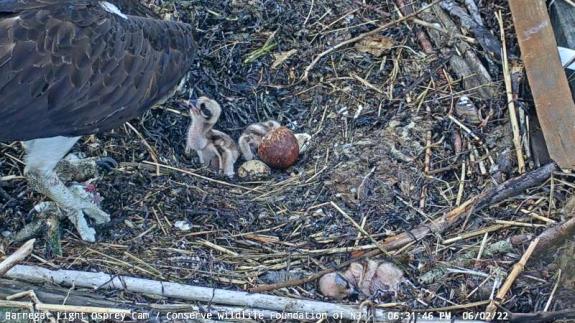 The third and youngest nestling was accidentally removed from the nest bowl by the adult female.
The third and youngest nestling was accidentally removed from the nest bowl by the adult female.
The third egg hatched during the day on June 2. That evening an unexpected event occurred, where the adult female accidentally removed that hatchling from the nest bowl. This put it outside the area where she provides parental care - feeding and brooding for it to stay warm and dry. The hatchling, not being able to see very well and move about the nest, remained in this area and survived downpours over night and into the next morning.
We monitored the situation very closely and made the careful decision to not interfere and save the hatchling. We debated calling our friends with a bucket truck to go there to save it, but we have already seen food stress at the nest this spring, so even if we were to place it back in the nest bowl, it would have had a severe disadvantage due to the age difference between it and the other two (older) hatchlings and the possibility of less prey to feed all three hungry mouths. The hatchling eventually passed away in the morning on June 3.
We thank all who support us, our work with ospreys and the BL Osprey Cam!
June 1
Hatching! The first two young have hatched! The first hatched early on May 31 (day 40) and the second hatched early this morning at 4am. If the third egg hatches then that hatchling will have a clear disadvantage if prey is not plentiful. Will share more information about the effects of weather, reduced prey availability and nest failures on the population in a blog post soon.. BW
May 11
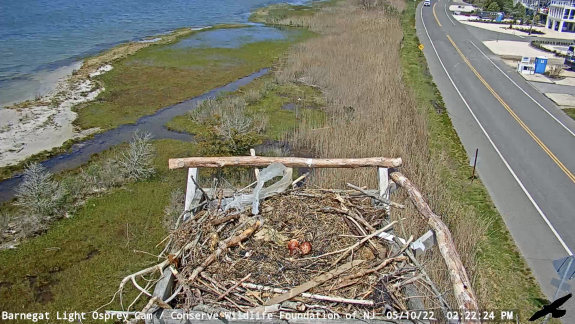 Zoom+ Something that we should never see during incubation -- unprotected/exposed eggs!
Zoom+ Something that we should never see during incubation -- unprotected/exposed eggs!
We are nearing the halfway point of incubation (Day 21 of egg 1 is 5/12) and all has been swell, with Duke taking turns to incubate while Daisy feeds and stretches her wings. This happens like clockwork, every day, until the eggs begin to hatch. Over the past several days, after a strong low pressure system moved into the area last Friday, winds have been steady and strong from the northeast. Temps have been locked in 50s for the past week. On top of that, long periods of heavy rain battered the coast. With windy, cool (and possibly wet) conditions expected to persist for another few days, ospreys along the coast will struggle to battle food stress and maintaining the health of their clutch of eggs.
Weather plays a huge role in the outcome of osprey nests. Over the past five days it has been challenging for sure. Foraging (finding and catching prey) for fish eating birds during prolonged periods of heavy rain, wind and cloudy conditions will limit where they can find prey (open ocean and west side of bays are too rough) to back bays, inland lakes/rivers, and smaller coves and creeks. At this nest, we have witnessed the reduction in prey deliveries and incubation exchanges. On top of the high winds, etc has been coastal flooding from the onshore flow from the low pressue system offshore.
Just yesterday, Daisy left the nest and her eggs unprotected for 27 minutes so that she could feed.. Viewers have noted the reduction in prey deliveries (5-7) over the past several days, when we usually see multiple prey deliveries and incubation exchanges every day. Duke has not been acting normal, and it seems to be linked to the recent weather. While embryos are "less sensitive to cold than to heat," it is still concerning to see them exposed for such a long time (they are vulnerable to predators), especially on a very cool day. BUT, Daisy does need to eat.
The question is ... why is Duke, a very experienced adult male, who has foraged in New Jersey waters for his entire life, not able to find and catch prey to provide his mate? So far today, @ 11am, no prey has been delivered to Daisy. The last fish she ate was yesterday ~ 2:30pm when her eggs were left unattended. Time will tell what plays out and we can hope that the weather improves for the health of all ospreys in coastal New Jersey.
April 27
A lot has happened since my last update.. The female is now incubating a full clutch of three eggs! The first egg was laid on 4/21 ~ 3pm, 2nd on 4/24 and third on 4/27. It was so great to see the excitement of Duke when he got a glimpse of the first egg (highlight video in the works)! The pair have been taking turns to incubate their clutch of eggs, which will begin to hatch around the last day of May and into the first week of June, which is the normal time when we see hatching at osprey nests throughout the state.
There have been several red banded ospreys that have come into view of the cam this spring, but nailing their ID has been difficult. One day we hope to see a red banded adult osprey nest here, which will really be quite the treat! -BW
April 18
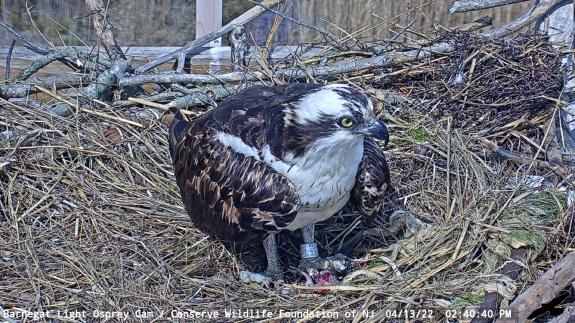 Duke! He is back!
Duke! He is back!
Duke (788-49033 / banded July 12, 2006 @ Sedge Islands)! The patriarch of the BL Osprey Cam is back!! Right after my last update the previous male returned; right on schedule! He came back late, as usual, and usurped any and all interlopers. As you can see in the snapshot of Duke above, his unique iris pattern and federal band on his left leg are key identifiers. In addition, the plumage of Duke's upper wing coverts are faded, which for me, is remanisant of a Ridgway's osprey, which is a non-migratory osprey subspecies that inhabits the tropical region of the Western Hemisphere. In February 2017, I joined a small group of researchers to document nest occurance of coastal nesting Ridgway's in Belize, the southern most nesting ospreys in the Western Hemisphere, as no ospreys nest in South America (but where most North American ospreys winter). I hope to join another expedition to Belize in 2023, as we attempt to conduct a follow up census of Ridgway's ospreys.
Back to Duke, all viewers have seen what it takes to win the heart of a female osprey -- 🐟 ! At first Daisy wasn't too sure of Duke, since she was already starting to form a pair bond with another male, but after Duke settled in an provided her with a plentiful supply of fish, their pair bond was re-established. They have copulated many times since his return, so eggs should be coming soon and I expect them to arrive earlier than last year (4/27). -BW
April 7
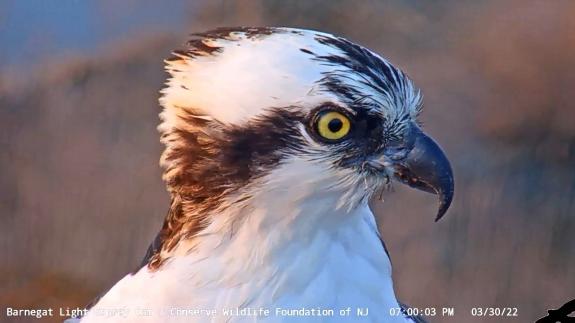 A young adult osprey, nicknamed "82" perched on the BL Osprey Cam nest during the golden hour.
A young adult osprey, nicknamed "82" perched on the BL Osprey Cam nest during the golden hour.
Over the past couple days and week, the live stream has been interesting to watch, with multiple males attempting to stake their claim on the nest. First, they need to impress the female (Daisy) by performing aerial courtship displays and most importantly, transferring food to her. While this has not really been observed on the nest by all of the males, mating attempts (some that looked successful) have been. It is interesting to see Daisy accept males long enough for them to attempt to mate with her, but few have transfered food to her, which makes her more receptive to breed. We all know that she is waiting (and hoping) for her tried and true mate, Duke to return.
In Alan Poole's book, "Ospreys: A Natural and Unnatural History" he describes early copulation attempts by males as a way to form a pair bond, synchronize the development of gonads, but have little to do with fertilization. When females arrive back from their wintering grounds, their ovaries are only partially developed, and undergo a period of rapid development. "In this phase, ovaries gain five to 15 times their initial weight before decending the oviduct (Lofts & Murton, 1973)."
Last year, Duke arrived on April 8, so I think it's safe to say that we are all anxiously waiting to see if this experienced adult male will return. If not, then it will be an interesting year at the nest to see if a male can win over Daisy and provide for his young. We know that the success of a nest is related to the male's ability to find and catch enough food for him, his mate and their offspring. -BW
March 29
This stretch of cold weather is likely to have ospreys re-thinking their early arrival here. With below freezing temperatures, high winds, and snow squals -- it does not feel like spring!
The same female has been back and has been adding nesting material to her nest. She has yet to reunite with her mate from last year - Duke. At least two other males have been observed on or near the nest with her and they have attempted mating - with no real success. Both are banded. One, with a band on his left leg was ID'd as: 1088-08856, a soon to be six year old banded by myself at a nest in Loveladies in July 2016. This is the first time re-sighting this osprey. Another banded male, called "Righty" by viewers has yet to be ID'd. Viewers have gotten xxxx-xxx82 so far. Both have eaten fish on or near the nest but haven't really offered much to Daisy, which would certainly improve their pair bond.. At least one was performing the "sky dance" over the nest, which is a high undulating flight over a nest, while often after a successful hunt, where the males calls with high pitch whistle calls.
Duke is known to arrive late, usually in April (he arrived on April 8 in 2021) so we're all watching and waiting to see if and when he will survive. If he does not, then this season will be more interesting than last year...
March 21
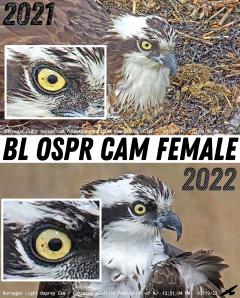 Zoom+ On March 19, 2022 both a male and female osprey were first observed on the BL OSPR Cam. Here is a comparison of the 2021 female and 2022 female to show her right eye for ID purposes.
Zoom+ On March 19, 2022 both a male and female osprey were first observed on the BL OSPR Cam. Here is a comparison of the 2021 female and 2022 female to show her right eye for ID purposes.
Both a male and female osprey have been observed on the BL Osprey Cam. A male was first observed on Saturday (3/19) morning and a female around mid-day. Today three ospreys were observed on cam, as another fermale landed on the nest and then a male flew in and had second thoughts about landing on the nest. The female who arrived on Saturday appears to be the same female, as you can see by the darker coloration on her yellow iris. She has already been working the nest. The male (1088-08822) who has been observed here has not yet allowed for close up inspection of his band, but we assume it is the same male who has tried to usurp the soon to be 16 year old male, named Duke.
We are seeking a volunteer camera operator who is willing to devote time to help control the BL Osprey Cam. For anyone interested, you can apply here.
In other news, we are still not recording video for highlights, but did just purchase a new hard drive that needs to be installing with the network equipment at the nest. Hope to get this done on Saturday morning when we visit the area to replace a nest platform. -BW
March 15, 2022
The new weather station, which was donated by Jackie Jetton (Twist's mother) was installed last week at the osprey cam, so we have data on temperature, wind speed and more! Now we will know when a sea breezes kicks in (besides observing the birds facing east) and when it's beastly hot at the nest...
The nest is all set for them to return, as it was enhanced late last year. The only thing we need to re-install is the local recording device to store video. We're in the (long process) of reviewing footage from last year to make a season long video (might be a multipart series). We would buy a new hard drive to install in the storage device, but they are all on backorder.. So, if you see an osprey on the nest, please take a snapshot and email Ben Wurst.
Find Related Info: Osprey




